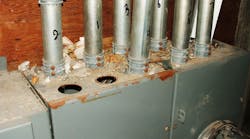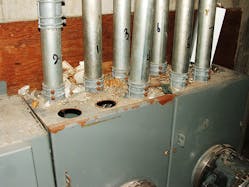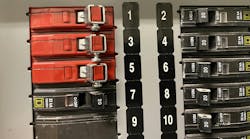How well do you know the Code? Think you can spot violations the original installer either ignored or couldn't identify? Here's your chance to moonlight as an electrical inspector and second-guess someone else's work from the safety of your living room or office. It's your turn to identify the violation.
Hint: This gives me a hollow, empty feeling inside
Find the Answer
This is a disaster waiting to happen. Look at all the debris on top of this enclosure. There are meter tags, screws, locknuts, bolts, and all kinds of other debris strewn on top of this enclosure. Now look at the large holes sitting right above one of those meters. This is a really bad combination. If some of that metal debris were to be inadvertently knocked into those openings it could be a disaster in the making. An electrical explosion could damage equipment, cause a power interruption, and, more importantly, cause injury or even worse to a worker.
These openings must be properly closed up. Section 110.12(A) requires unused openings to be closed and afford protection similar to the wall of the enclosure. Knockout seals would do the trick here. Unfortunately, this is an all too common occurrence that I see in the field. Another problem with allowing these gaping holes to exist is the easy access it allows for critters, such as mice or chipmunks, to get inside the enclosure. The rodents can wreak havoc when they get inside a piece of electrical equipment — although it typically doesn’t work out very well for them once they start chewing on conductor insulation or make contact with the energized parts.





